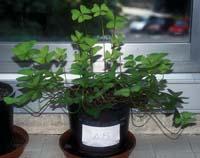Types of barabase-herbs in the Basque Country

The annual cycle of this plant begins in spring, towards April and May, when with the increase of temperature that means spring, the underground bulbs are activated and, once the roots have developed, the leaves emerge. Then the summer growth occurs, stage in which it produces more leaves and small bulbs. At this time it also develops flowers, but there are those who think it does not fructify because the reason that the fruits do not develop lies in the characteristics of the flowers of this species. The barrabasa, South American, develops in its original territory at least two types of flowers (in different individuals); to carry out fertilization, a type of flower should collect pollen of the other type. But it seems that the population brought and spread here to Europe is of one type of flower, so the plants cannot develop the fruit, since they cannot fertilise themselves. This feature is called heterostilia.
Inside the summer crop, and if the bulb is close to the surface, fattens 1, 2 or 3 among the numerous roots it develops. The function of these roots is to supply water and food to the bulbs, but above all, to equal the annual growth of the bulb by pulling down to prevent little by little the terrestrial surface.
In autumn, as the temperature drops, the barab-hay is losing the leaves; the small developed bulbs are separated by the mother of the bulb and the mentioned thick roots contract. Finally, towards the winter, after losing all the leaves, it remains in cultivation state until the spring of the following year.

The barrabasa is easily recognizable: it resembles a clover (in fact, each leaf has three puffs) and has very beautiful pink flowers. The leaves are formed by the top of a bulb, although inside the bulb they are born in a cone shaped stem. Precisely in this bulb lies the harmfulness of the grass of the bars. From spring to autumn, the bulb radially expands the estolones (underground and superficial ramifications that a stem develops for asexual reproduction), creating at its end other small bulbs.
In autumn, with function, the estolones disappear but not the bulbs. Each small bulb will continue to grow the following year and generate more bulbs. Each of them can produce an average of 25 small bulbs, which allows to multiply the population of barrabasa by 25 each year. In addition, the small size of the bulbs helps a lot to this expansion. On the one hand, it is difficult to separate the bulbs from the floor and, on the other, it facilitates enormously the transport, since it can be carried without realizing it along with the floor that remains under the boots or shoes.
Two types of barabbas
There are at least two types of barabbas. One of them has straight arista hardwood, like the tail of a fish (known in English as fish-tail oxalis), pink flowers, forming small bulbs at the ends of the estolones. That is the true herb of the barabbas, which appears in all the guides of plants. The other is of cardiac leaves, with curved edges, very light pink flowers, almost white, that create small bulbs glued to the mother or almost glued. This second type of barabbas was known so far as Oxalis latifolia Cornwall.
But when we do the thesis on biology and ecology of the barabbas in the University of Navarra, we find more differences between both types, such as the color of the scales of the bulbs and the number of veins, the degree of production of small bulbs, tolerance to humidity or drought. In the end, we saw clearly that both forms or types were different species. In addition, in Euskal Herria there are only six species (so far), but in the world at least 500 species are known within the genus Oxalis, many of them used in gardens, it would not be surprising that one of them would arrive in our territory and escape from the garden.

Taking into account all this, and after a thorough search, we have come to the conclusion that the form Cornwall is the species O. jacquiniana. The description of this species is found in the Internet magazine Malezas de México, which coincides with that made by Kunth in 1821. The photographs of the Mexican publication appear to be of form Cornwall and the characteristics of separation of O. jacquiniana O. latifolia coincide with those mentioned in our thesis (number of scales veins in 5 O. latifolia and 3 O. jacquiniana). However, the description of the plant does not correspond exactly to the shape of Cornwall: it says that the flowers are violaceous and rarely appear surrounded by small bulbs.
In any case, non-coincident characters are explicable. The color of the flowers can be really variable and, in terms of productivity, we know that in Europe this plant does not fructify (remember the heterostilia), so it is possible that, by not being able to perform a sexual reproduction, increase the production of small bulbs. As for the type of habitat, both species coincide. According to Dr. Heike Vibrans of Mexico, O. jacquiniana, like O. latifolia, is attracted by the raised lands (in this type of habitats we find O. latifolia in our territory).


There is, however, another species that may raise doubts: Oxaldebilis (= O. corimbosa ). This species, also very similar to the previous two, is found in the Basque Country. But the shape of their wafers is different: in the previous two the widest part of the wafers is located in the upper part, while those of O. weaks are wider in the central part; in addition, at the edges of the wafers, there are small calluses clearly visible with magnifying glass, unlike the previous two.
Based on these data, we can affirm that the Cornwall form of Oxalis latifolia is Oxalis jacquiniana. And why has it not been known that until now this species could be Oxalis jacquiniana? Because the bibliographic work on gender is not entirely clear.
Historical errors
In 1930 Knuth published a monograph of the genus Oxalis. According to some scientists, this monograph has many errors: several species appear with the same name and many identical species with the same name. This confused the knowledge of gender.

Later, in 1958, Young described species of the genus Oxalis that could be found in England, and was the first person to find two types within O. latifolia. It was referring to a typical form, which appears in all places in the form of herb-rabbits, but also describes a second type, abundant in the English counties of Devon and Cornwall. Both shapes were characterized by the shape of the puff pastry, the color of the flowers and the way to create small bulbs.
Over the years, some authors have accepted these two types without questioning that they could be different species. But, according to the studies carried out in our thesis, once revised the descriptions of the authors Kunth (1821), Knuth (1930) and Young (1958), and with the help of the digital magazine Malezas de México, we can now ensure that the true name of the form Cornwall is Oxalis jacquiniana.
Acknowledgments of thanks
My sincere thanks to Dr. Heike Vibrans for his explanations about O. jacquiniana, always agile and clear.
Bibliography Bibliography Bibliography
Buletina
Bidali zure helbide elektronikoa eta jaso asteroko buletina zure sarrera-ontzian











